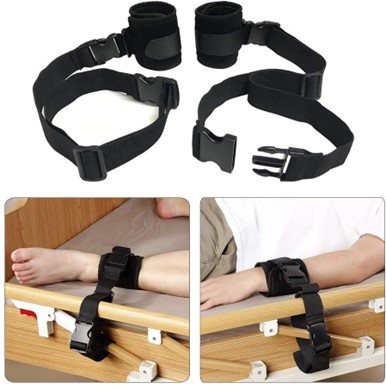A nurse is planning care for a client who has a prescription for extremity restraints on both wrists. Which of the following actions should the nurse include in the plan of care? (Select all that apply.)
Assess skin temperature and color before applying the restraints.
Ensure that the client's bed is in the lowest position.
Secure restraints to allow three fingers to slide under the restraints.
Pad bony prominences before applying the restraints.
Attach the client's restraints to the bed rail.
Correct Answer : A,B,C,D
When planning care for a client who has a prescription for extremity restraints on both wrists, the nurse should assess the client's skin temperature and color before applying the restraints to ensure that there is no circulation impairment. The nurse should also ensure that the client's bed is in the lowest position to prevent falls. The restraints should be secured to allow three fingers to slide under them to prevent injury and ensure proper circulation. Bony prominences should be padded before applying the restraints to prevent pressure injuries.
Option e is incorrect because attaching the client's restraints to the bed rail can cause injury if the bed rail is moved or adjusted.

Nursing Test Bank
Naxlex Comprehensive Predictor Exams
Related Questions
Correct Answer is B
Explanation
After moving clients to a safe location, the next action the nurse should take is to pull the fire alarm. This will alert others in the building to the presence of a fire and activate the building's fire suppression systems.
Options a, c, and d are not the next actions the nurse should take. Using an extinguisher to put out the fire may be appropriate if the nurse has been trained to do so and if it is safe to do so. Closing the doors to client rooms can help to contain the spread of smoke and fire, but it is not the next action the nurse should take. Turning off electrical equipment in the room may help to prevent further ignition sources, but it is not the next action the nurse should take.
Correct Answer is A
Explanation
Decreased judgment is a common sign of sleep deprivation. When a person is sleep deprived, their cognitive function can be impaired, leading to difficulty making decisions and exercising good judgment.
Options b, c, and d are not necessarily indicative of sleep deprivation. Decreased activity can be a sign of many different conditions, including fatigue or depression. Increased reflexes and increased auditory alertness are not commonly associated with sleep deprivation.
Whether you are a student looking to ace your exams or a practicing nurse seeking to enhance your expertise , our nursing education contents will empower you with the confidence and competence to make a difference in the lives of patients and become a respected leader in the healthcare field.
Visit Naxlex, invest in your future and unlock endless possibilities with our unparalleled nursing education contents today
Report Wrong Answer on the Current Question
Do you disagree with the answer? If yes, what is your expected answer? Explain.
Kindly be descriptive with the issue you are facing.
